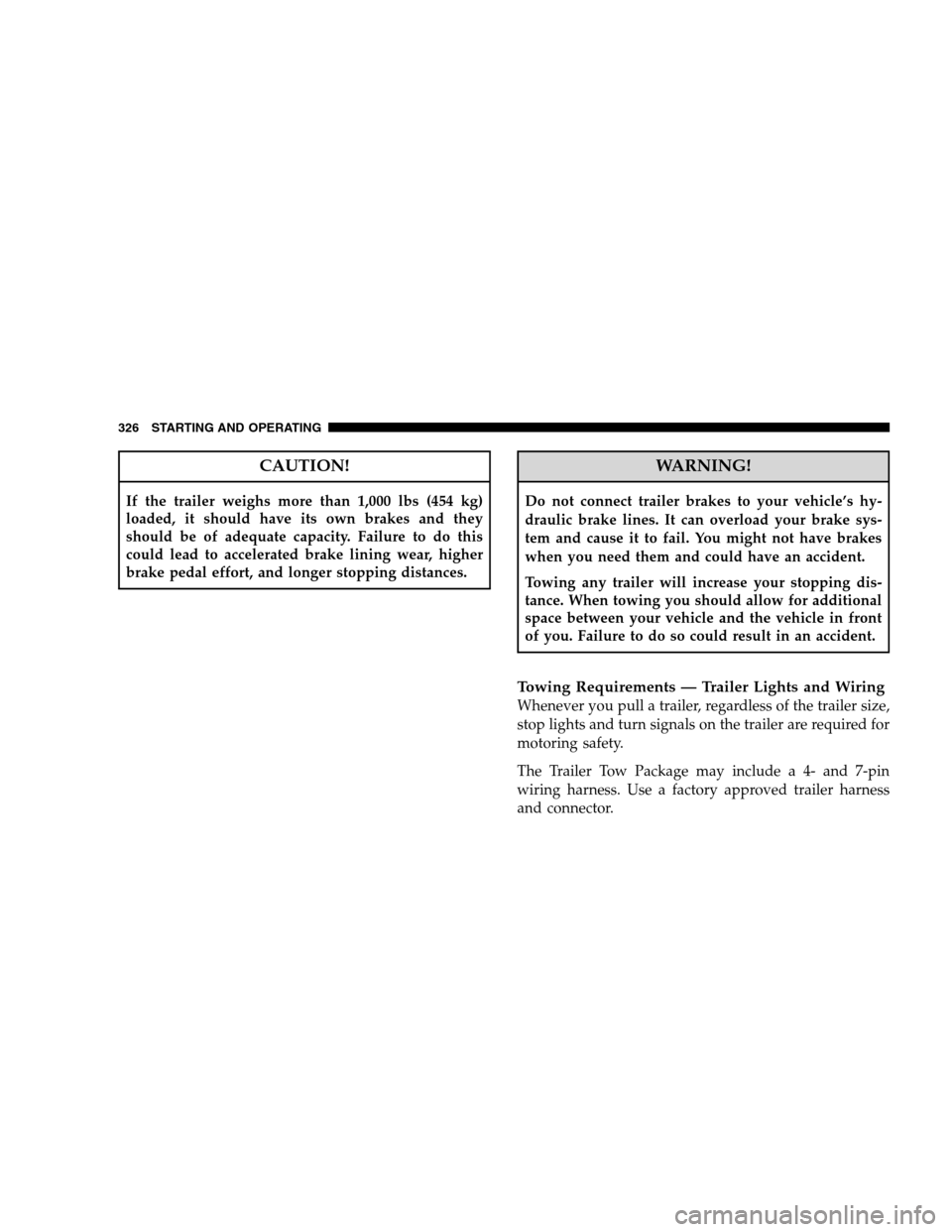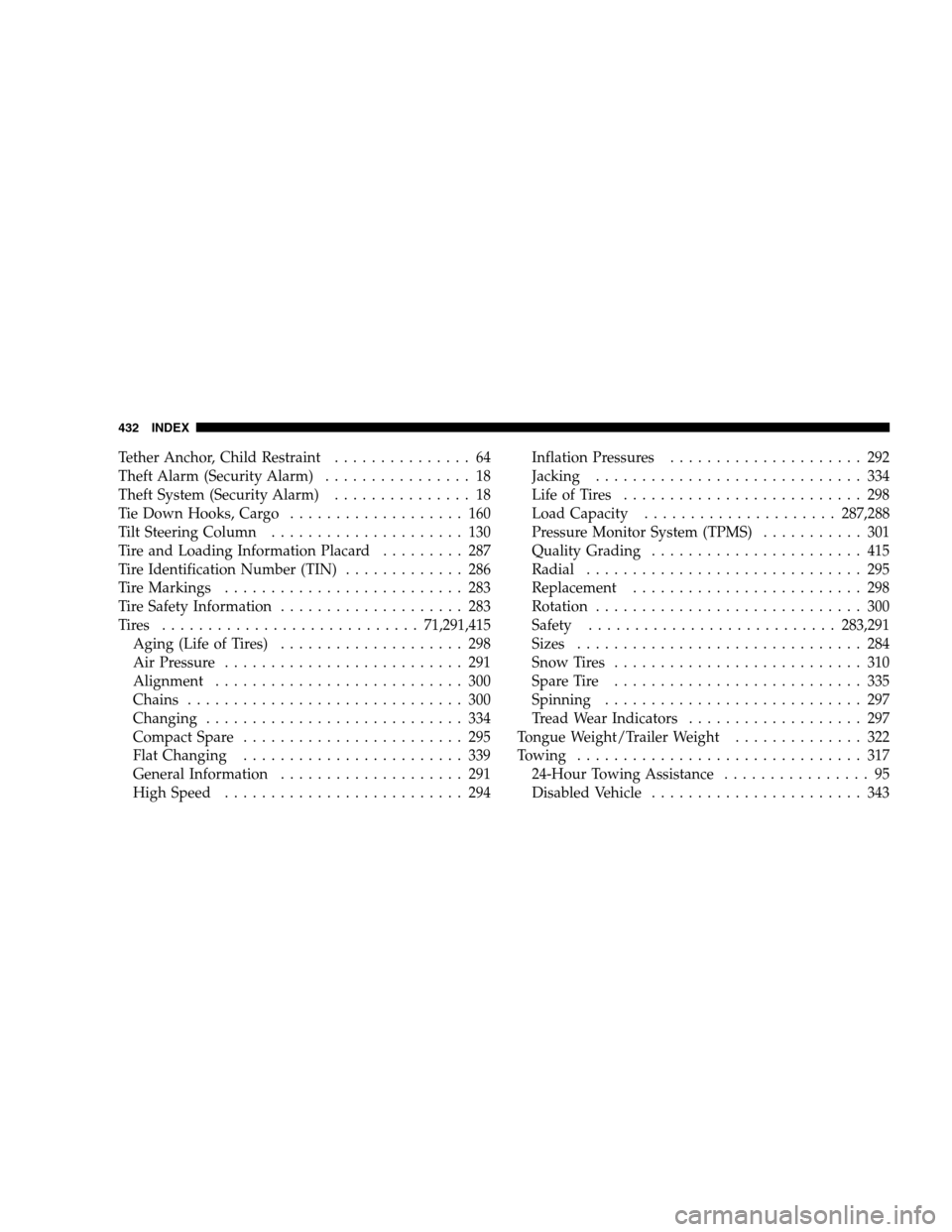Page 320 of 438

Common Towing Definitions
The following trailer towing related definitions will assist
you in understanding the information:
Gross Vehicle Weight Rating (GVWR)
The GVWR is the total allowable weight of your vehicle.
This includes driver, passengers, cargo and tongue
weight. The total load must be limited so that you do not
exceed the GVWR.
Gross Trailer Weight (GTW)
The gross trailer weight (GTW) is the weight of the trailer
plus the weight of all cargo, consumables and equipment
(permanent or temporary) loaded in or on the trailer in its
�loaded and ready for operation�condition. The recom-
mended way to measure GTW is to put your fully loaded
trailer on a vehicle scale. The entire weight of the trailer
must be supported by the scale.
Gross Combination Weight Rating (GCWR)
The gross combination weight rating (GCWR) is the total
permissible weight of your vehicle and trailer when
weighed in combination.
NOTE:The GCWR ratings include a 150 lbs (68 kg)
allowance for the presence of a driver.
Gross Axle Weight Rating (GAWR)
The GAWR is the maximum capacity of the front and rear
axles. Distribute the load over the front and rear axles
evenly. Make sure that you do not exceed either front or
rear GAWR.
WARNING!
It is important that you do not exceed the maximum
front or rear GAWR. A dangerous driving condition
can result if either rating is exceeded. You could lose
control of the vehicle and have an accident.
318 STARTING AND OPERATING
Page 327 of 438

4. Tongue weight rating for the trailer hitch utilized
(This requirement may limit the ability to always
achieve the 10% to 15% range of tongue weight as a
percentage of total trailer weight).
Towing Requirements — Tires
�
Do not attempt to tow a trailer while using a compact
spare tire.
�Proper tire inflation pressures are essential to the safe
and satisfactory operation of your vehicle. Refer to the
Tires – General Information section of this manual on
Tire Pressures for proper tire inflation procedures.
�Also, check the trailer tires for proper tire inflation
pressures before trailer usage.
�Check for signs of tire wear or visible tire damage
before towing a trailer. Refer to the Tires–General
Information section of this manual on Tread Wear
Indicators for the proper inspection procedure.
�When replacing tires refer to the Tires–General Infor-
mation section of this manual on Replacement Tires for
proper tire replacement procedures. Replacing tires
with a higher load carrying capacity will not increase
the vehicle’s GVWR and GAWR limits.
Towing Requirements — Trailer Brakes
�
Donotinterconnect the hydraulic brake system or
vacuum system of your vehicle with that of the trailer.
This could cause inadequate braking and possible
personal injury.
�An electronically actuated trailer brake controller is
required when towing a trailer with electronically
actuated brakes. When towing a trailer equipped with
a hydraulic surge actuated brake system, an electronic
brake controller is not required.
�Trailer brakes are recommended for trailers over 1,000
lbs (454 kg) and required for trailers in excess of 2,000
lbs (907 kg).
STARTING AND OPERATING 325
5
Page 328 of 438

CAUTION!
If the trailer weighs more than 1,000 lbs (454 kg)
loaded, it should have its own brakes and they
should be of adequate capacity. Failure to do this
could lead to accelerated brake lining wear, higher
brake pedal effort, and longer stopping distances.
WARNING!
Do not connect trailer brakes to your vehicle’s hy-
draulic brake lines. It can overload your brake sys-
tem and cause it to fail. You might not have brakes
when you need them and could have an accident.
Towing any trailer will increase your stopping dis-
tance. When towing you should allow for additional
space between your vehicle and the vehicle in front
of you. Failure to do so could result in an accident.
Towing Requirements — Trailer Lights and Wiring
Whenever you pull a trailer, regardless of the trailer size,
stop lights and turn signals on the trailer are required for
motoring safety.
The Trailer Tow Package may include a 4- and 7-pin
wiring harness. Use a factory approved trailer harness
and connector.
326 STARTING AND OPERATING
Page 434 of 438

Tether Anchor, Child Restraint............... 64
Theft Alarm (Security Alarm)................ 18
Theft System (Security Alarm)............... 18
Tie Down Hooks, Cargo................... 160
Tilt Steering Column..................... 130
Tire and Loading Information Placard......... 287
Tire Identification Number (TIN)............. 286
Tire Markings.......................... 283
Tire Safety Information.................... 283
Tires ............................ 71,291,415
Aging(LifeofTires) .................... 298
Air Pressure.......................... 291
Alignment........................... 300
Chains.............................. 300
Changing............................ 334
Compact Spare........................ 295
Flat Changing........................ 339
General Information.................... 291
High Speed.......................... 294Inflation Pressures..................... 292
Jacking............................. 334
LifeofTires .......................... 298
Load Capacity.....................287,288
Pressure Monitor System (TPMS)........... 301
Quality Grading....................... 415
Radial.............................. 295
Replacement......................... 298
Rotation............................. 300
Safety...........................283,291
Sizes ............................... 284
Snow Tires........................... 310
Spare Tire........................... 335
Spinning ............................ 297
Tread Wear Indicators................... 297
Tongue Weight/Trailer Weight.............. 322
Towing ............................... 317
24-Hour Towing Assistance................ 95
Disabled Vehicle....................... 343
432 INDEX